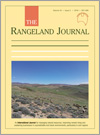RJ17006Feeding flocks on rangelands: insights into the local ecological knowledge of shepherds in Boulemane province (Morocco)
The development of semi-arid and mountain areas depends on the sustainable use of rangelands, which relies on local ecological knowledge (LEK). LEK about plants and animal foraging behaviour varies with the local agricultural context and the status of the shepherd; loss of LEK and of its connection to grazing management is observed where pastoralism is less valued. The perpetuation of LEK will depend on the ability of extension services to assess it and to foster its improvement and dissemination.




